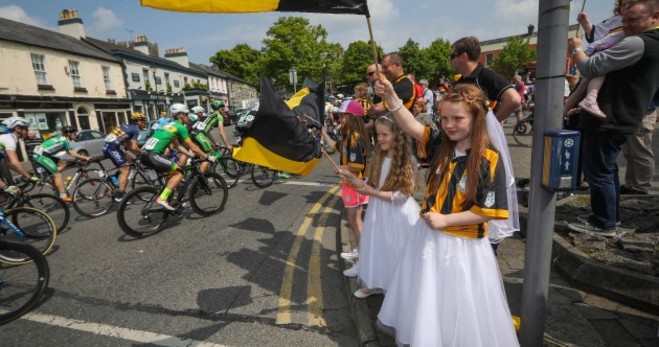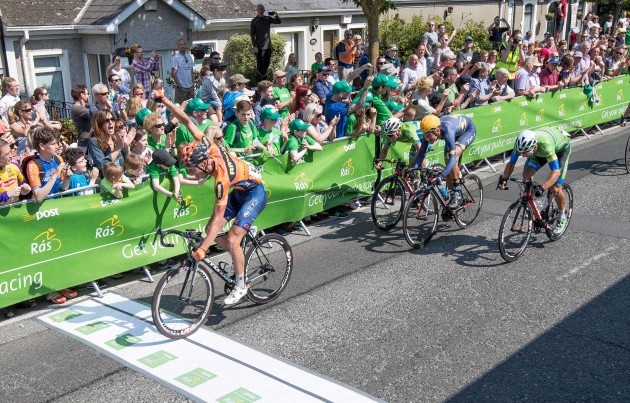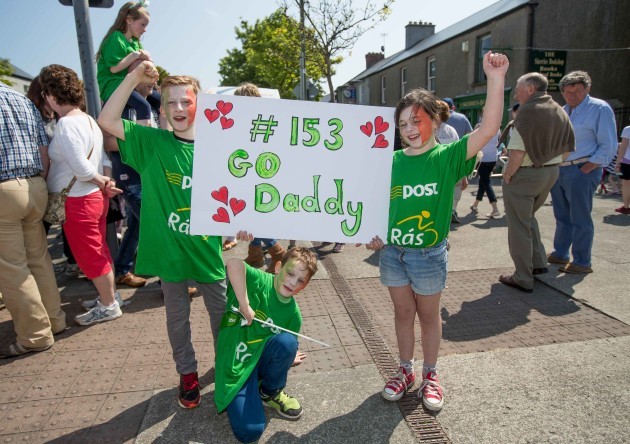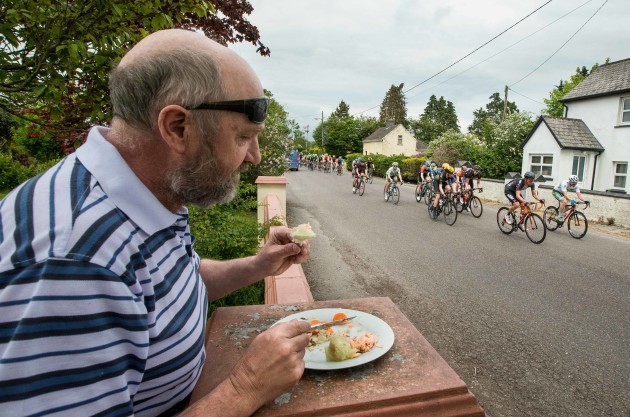THE CROWDS MUST have been half a dozen rows deep, thousands lining the route as the An Post Rás arrived into Skerries. It had been building towards this crescendo all day, all week.
The sense of anticipation grew as the kilometres ticked down. 148km. 100km. 50km. 5km. 500m. Then, the roar. The beeping of horns. The unmistakable sound of clappers, reverberating around the seaside town.
The place had come to a standstill. The Skerries main street transformed into a sporting amphitheatre as those fortunate enough to have a good vantage point witnessed a thrilling climax to eight days of racing.
The crowds – family, friends and fans – giddy on an afternoon of sun and exhilarated by the scores of riders, averaging speeds of 47km/h, weaving through the streets of the town.
The final stage of the Rás facilitates this grandstand finish. Three laps of Skerries draws every last sinew from the riders but generates a partisan atmosphere which had been building all morning.
It’s Skerries’ chance to shine and, boy, does this town come alive. The weather always helps. Anyone you ask around here insists it has never rained for the final day of the Rás; and you’d believe them too.
When the final bell rings, the decibel levels increase. The peloton, bunched from the start in Kildare, break. After three ascents of the Black Hills climb, James Gullen – rider number 42, aptly – sprints clear.
With just two kilometres and the final crowd-thronged stretch remaining, he’s reeled in. It’s a sprint finish, from which Nicolai Brochner emerges victories after timing his assault to perfection.
The other 148 riders follow him over the line, many of whom are amateurs or county riders. It’s what makes the Rás so unique as amateur cyclists rub shoulders with professional teams from around the world.
Clemens Fankhauser, the Austria Tirol Cycling rider, lifts the coveted trophy for the second time in three years and then that’s it. For another year, anyway.
Four hours previous, final preparations are being made by riders and mechanics in a field just outside Kildare town centre. For what is to follow, it’s an unglamorous start to the day.
As twelve noon approaches, the riders assemble for a ceremonial journey to the start line at Kildare town’s post office. Already there are locals out in force, catching a brief glimpse of the peloton as it speeds past their house.
We’re part of the neutral service for the day, a car which offers mechanical support to any rider in need of assistance during the 148 kilometre final stage.
The race’s pro teams have their own cars, as do many of the amateurs outfits, but if a rider suffers a puncture, time is at a premium and they can often ill-afford to wait for their team car to come to their aid.
The cavalcade (the line of cars which follows the riders) is a fascinating part of the race in itself. Each team car is designated a position in the line, depending on how their riders are placed in the general classification.
As neutral service, we’re third behind the Race Director, Tony Campbell, and the Commissaire (the race referee). It gives us a perfect view of proceedings.
The race is led by members of the Gardaí traffic corps and assisted by volunteer motor cyclists, who will ride ahead and ensure no cars find their way onto the route.
Logistically, it’s months in the planning and requires the co-operation of every council, authority and member of the public. One oversight could have catastrophic consequences.
But that’s what makes the An Post Rás the event it is. Many of those involved are volunteers, giving up a week, and more, of their time to organise, co-ordinate and oversee the country’s only professional cycling race.
Then there are the towns and villages it passes through. Each opening its door and using the event as an opportunity to put themselves on the map. Skerries, for example, has become synonymous with the race finale.
For communities around the country, the Rás means something. It is an event which provides local economies with a welcome injection of income and tourist footfall.
It comes and goes in a flash but the fleeting visit to each and every community is undeniable proof of the empowering effect sport can have.
People of all generations line the streets. Grannies, Granddads, Grandchildren. Local schools are given time out of the classroom to cheer on the Rás.
Not only is the Rás world class cycling with Ireland’s picturesque countryside acting as a truly unique backdrop but it encapsulates the time-worn traditions and values of rural Ireland, which may have become lost in these contemporary times.
Through one of the towns, churchgoers filter out of Mass just in time to welcome the peloton through their main street. Two young girls, waving the local GAA flag, have just made their communion.
Back in the car, we have our first puncture. One of the mechanics hops out of the back seat to change the wheel in doubly quick time. Then, the fun part. We have to regain our position in the caravane, speeding up on the outside of the rest of the cars whilst dodging cyclists in the process.
From the outside looking in, and certainly for non-cycling enthusiasts, the Rás is a glorified bike race. You see packs of cyclists on the side of a road anywhere in the country on any given day but there’s something romantic about this.
Cycling is a sport which naturally draws scepticism but between the energy of the riders and the enthusiasm of the onlookers, it’s hard not to become gripped by it all.
At one stage, yours truly was called upon to hand bottles out the window to cyclists, who would tuck them up their shirt to then carry forward to their team-mates in the pack.
It’s an incredibly tactical sport. Team cars will look for permission to come to the top of the caravane to speak to their riders at different junctures and it’s not until you see it first hand that you fully appreciate what’s really involved.
Away from the doping scandals and the negatives, this is cycling at a rudimentary level, and sport at its captivating best.
The Rás, in its 65th year, is an event which has evolved with time. It now attracts riders and media attention from all over the world but it remains quintessentially Irish.
Through Multyfarnham, Charleville, Dingle, Sneem, Clonakilty, Dungarvan, Baltinglass and Skerries, every single person plays their part in what makes it so special – and why year after year the crowds get bigger and bigger.
The42 is on Snapchat! Tap the button below on your phone to add!





